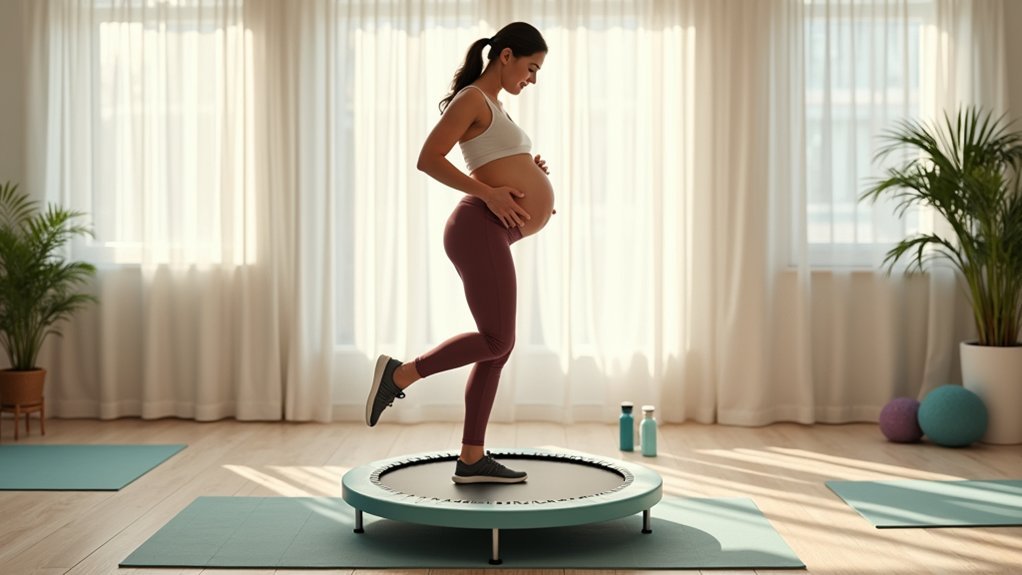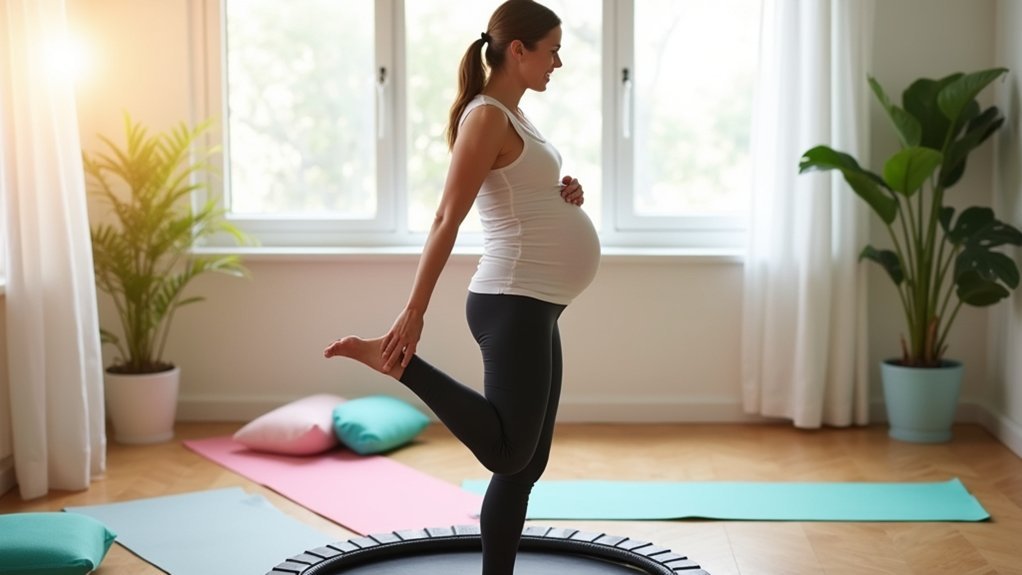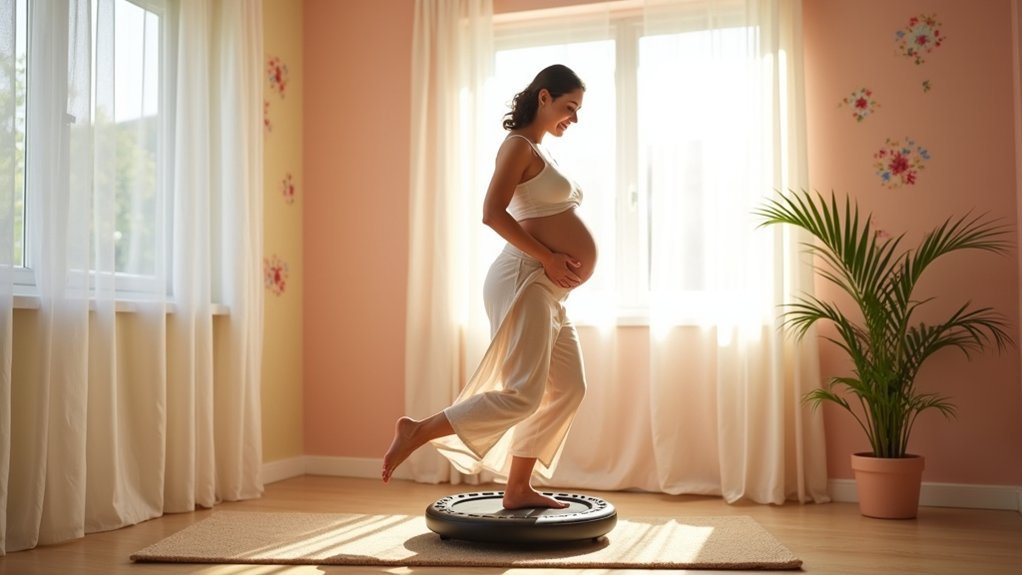During early pregnancy, you can safely enjoy gentle rebounding on a mini-trampoline with proper modifications. Keep both feet on the mat while doing controlled marches, shallow bounces, and lateral steps. Always use a trampoline with handlebars, engage your core, and limit vertical movement to less than 2 inches. Stop immediately if you experience dizziness, pain, or unusual symptoms. Consulting your healthcare provider before starting guarantees your bounce routine supports—rather than stresses—your changing body.
Understanding the Fundamentals of Rebounding During Pregnancy

While pregnancy often requires exercise modifications, rebounding can be a viable low-impact option when performed correctly. When you’re bouncing on a mini-trampoline, you’re engaging in controlled vertical movements that put less stress on your joints compared to jogging or running.
Proper rebounding technique requires activating your pelvic floor and abdominal muscles to maintain balance and protect your growing uterus. Look for mini-trampolines with handlebars for added stability—these are essential during pregnancy. Regular exercise with proper technique can help strengthen your core muscles which enhances your stamina and pushing power during labor.
Focus on small, controlled movements rather than high bounces to prevent sudden shifts in your body position. The biomechanics of gentle rebounding can provide cardiovascular benefits without the jarring impact of other exercises, making it a potential exercise option throughout your pregnancy when performed with appropriate modifications.
The Science Behind Low-Impact Bouncing in First Trimester
Although your body undergoes significant changes during the first trimester, low-impact bouncing can still be physiologically appropriate when properly executed. The hormone relaxin increases joint laxity, requiring movements with controlled amplitude—ideally less than 2 inches of vertical displacement—to prevent instability.
Your cardiovascular system prioritizes maintaining stable maternal-fetal circulation over intensity, so keeping your heart rate below 120 BPM is essential. Core mechanics also shift as your uterus grows, necessitating proper alignment with an engaged transverse abdominis. It’s important to note that contact sports and activities with jerky, bouncing movements should be strictly avoided during pregnancy to protect both mother and baby.
During pregnancy, prioritize stable circulation by maintaining your heart rate under 120 BPM while engaging your transverse abdominis for proper alignment.
Research from ACOG and MARCH indicates no significant miscarriage risk from moderate activity when following safety protocols.
Always exercise on shock-absorbent surfaces, maintain a neutral spine, and monitor your perceived exertion (keeping it below 14/20). Stop immediately if you experience dizziness or contractions.
Modified Rebounding Techniques for Expectant Mothers

Traditional rebounding exercises must be considerably modified during pregnancy to protect both mother and baby. Instead of bouncing, opt for controlled lateral steps or gentle marches that minimize pelvic floor stress and prevent ligament strain.
When using a rebounder, engage your transverse abdominals to stabilize your pelvis during movement. Avoid standing motionless, as this reduces blood flow. Try march-in-place exercises with arm variations, maintaining a neutral spine and monitoring your exertion with the “talk test.” Always ensure you can maintain conversation while performing these exercises to avoid overexertion.
For pelvic floor protection, incorporate step-tap movements at the trampoline edges while keeping a slight bend in your knees. You can also perform lateral lunges with hand support on the rebounder surface, activating your obliques during directional changes but limiting your range to pain-free motions.
Balance and Stability Practices on Mini-Trampolines
Balance and stability practices on mini-trampolines demand special consideration during early pregnancy due to significant changes in your body’s center of gravity.
The hormone relaxin loosens your ligaments, making you more susceptible to falls and injuries while bouncing.
Always hold onto a stable support like a handrail when using a mini-trampoline. Exercise barefoot to improve foot-to-surface connection and enhance stability.
Safety first! Grip a stable handrail and bounce barefoot to maximize stability on your mini-trampoline during pregnancy.
Consider placing safety mats around your mini-trampoline to cushion potential falls.
Have a spotting partner nearby during your sessions, especially as your pregnancy progresses.
Focus on proper breathing techniques to maintain core stability while bouncing. When approaching rebounding during pregnancy, remember there is no universal answer as each woman’s pregnancy journey is unique and requires individualized consideration.
Remember that low-impact alternatives like walking might be safer options if you’re experiencing balance difficulties.
Always consult your healthcare provider before continuing or starting mini-trampoline exercises during pregnancy.
Gentle Rebounding Routines for Morning Sickness Relief

You’ll find gentle, rhythmic movements on your mini-trampoline can offer surprising relief for morning sickness.
Try incorporating lateral sways and shallow bounces while focusing on timed breathing patterns that help regulate nausea-triggering hormones.
Press your wrists gently against the rebounder’s handlebars during your routine to activate pressure points that may further reduce pregnancy-related queasiness.
However, be mindful that these exercises still create increased pressure on your pelvic floor, which requires monitoring for any signs of discomfort.
Nausea-Reducing Movements
While many pregnant women experience morning sickness during their first trimester, gentle rebounding routines can offer surprising relief from nausea symptoms.
Focus on controlled, smooth movements rather than jarring jumps that could stress your pelvic floor.
Try light bouncing while seated on an exercise ball, which improves circulation without increasing abdominal pressure. Small, gentle side-to-side or forward-backward movements can help stabilize hormones associated with morning sickness. These gentle exercises can enhance your mood and help reduce stress during this challenging phase of pregnancy.
Remember to breathe deeply throughout these exercises to maximize oxygen flow.
Always stay hydrated and avoid exercising after heavy meals. If you feel increased discomfort, stop immediately.
Before starting any rebounding routine, consult your healthcare provider to verify it’s appropriate for your specific pregnancy.
Many women find these gentle movements not only reduce nausea but also improve overall mood and stress levels.
Gentle Pressure Points
Combining gentle pressure point stimulation with rebounding exercises can greatly enhance morning sickness relief during early pregnancy. While on your mini trampoline, apply gentle pressure to the P6 point (three fingers’ width above your wrist) between movements to help alleviate nausea. This combination activates your body’s natural relaxation response while keeping movements low-impact. For most women, this technique is especially helpful since approximately 80% of pregnant individuals experience nausea and vomiting during early pregnancy.
For best results, try these pressure point techniques during your rebounding routine:
- Press the LI4 point (between thumb and index finger) for 30 seconds while taking slow breaths.
- Combine gentle bouncing with consistent breathing patterns to maximize relief.
- Alternate between stationary pressure holds and slow, controlled movements.
Remember to maintain proper posture and use supportive equipment like trampolines with handlebars to guarantee safety throughout your session.
Core Engagement Without High-Impact Movements
When working on your core during early pregnancy, you’ll benefit from seated stability exercises that support your changing body without jarring movements.
Belly-safe breathing techniques like the connection breath engage your transverse abdominis while protecting your growing baby.
Modified pelvic tilts can strengthen your core muscles while maintaining a neutral spine, which helps prevent back pain as your pregnancy progresses. These exercises are especially important as they help strengthen pelvic organs as your baby bump develops in the second trimester.
Seated Stability Exercises
Three essential benefits make seated stability exercises ideal for expectant mothers in early pregnancy.
They notably reduce back pain by strengthening core muscles that support your changing body. You’ll also improve posture through exercises like seated pelvic tilts, which enhance pelvic alignment as your center of gravity shifts.
Plus, these movements can lead to easier labor by building functional strength. When performing seated exercises, remember to avoid overheating and stay properly hydrated throughout your workout session.
Try these pregnancy-safe seated exercises:
- Modified V-Sit – Perform on a bench to strengthen your core without straining your back
- Opposite Arm/Leg Raise – Enhance balance and stability while engaging core muscles
- Seated Side Bends with Resistance Band – Improve lateral strength and posture
Always consult your healthcare provider before starting any pregnancy exercise routine, following ACOG guidelines for safety.
Belly-Safe Breathing Techniques
Breathing properly becomes increasingly essential during early pregnancy as your body undergoes significant respiratory changes. With progesterone promoting slower breathing patterns and your expanding uterus gradually compressing your diaphragm, targeted breathing exercises can help optimize oxygen flow while engaging your core without strain. Incorporating these techniques into your regular physical activities can help maintain overall wellness during pregnancy.
| Technique | Benefits | How to Practice |
|---|---|---|
| Diaphragmatic Breathing | Improves oxygen intake, gently engages core | Inhale slowly through nose, allowing chest to expand, exhale gradually |
| Relaxed Inhalation | Reduces stress, supports pelvic alignment | Breathe in for 4 counts, hold briefly, exhale for 6 counts |
| Alternating Nostril Breathing | Balances respiratory function, promotes calm | Close right nostril, inhale through left, switch sides, repeat |
Remember to avoid forceful breathing techniques like Kapalabhati. Instead, focus on deep yet relaxed breathing patterns in comfortable seated positions that support your changing body.
Modified Pelvic Tilts
Modified pelvic tilts offer pregnant women a gentle yet effective way to strengthen core muscles without risking harmful impact on the developing baby. This exercise targets your transverse abdominals and pelvic floor, providing essential support as your uterus expands while minimizing lower back strain.
To perform safely during early pregnancy:
- Use supportive props – Try a stability ball or perform on hands and knees to avoid supine positions.
- Maintain proper form – Focus on gentle movements without hyperextending your spine.
- Listen to your body – Limit repetitions to 10-20 and stop immediately if experiencing discomfort.
These controlled movements not only alleviate current discomfort but also prepare your body for labor by improving pelvic flexibility and potentially optimizing fetal positioning—benefits you’ll appreciate as your pregnancy progresses. Regular practice can help widen the pelvis for more favorable baby positioning during childbirth.
Cardiovascular Benefits of Controlled Bouncing
When performed correctly, controlled bouncing exercises offer remarkable cardiovascular benefits for expecting mothers in early pregnancy. You’ll strengthen your heart while improving circulation and oxygen delivery to both your tissues and your baby’s. Exercise during pregnancy should always be discussed with your ob-gyn during prenatal visits to ensure it’s appropriate for your specific situation.
| Benefit | How It Helps You |
|---|---|
| Enhanced Heart Function | Strengthens cardiovascular system through rhythmic movement |
| Improved Circulation | Delivers more oxygen to maternal and fetal tissues |
| Metabolic Boost | Lowers glucose levels and reduces insulin resistance |
| Labor Preparation | Builds stamina and strengthens core muscles for delivery |
| Long-Term Health | Reduces risks of preeclampsia and excessive weight gain |
Regular bouncing also prepares your body for labor by increasing endurance and strengthening pelvic floor coordination. The benefits extend beyond pregnancy too—you’ll likely experience faster postpartum recovery and establish healthy exercise habits for life.
Doctor-Approved Rebounding Exercises for Weeks 1-12
Your modified rebounding routine during weeks 1-12 should incorporate low-impact movements like mini-squats and seated stability ball bounces instead of traditional jumping.
Watch for safety signals including dizziness, contractions, or vaginal bleeding, which require immediate session termination.
Remember to use non-slip mats and supportive footwear while maintaining proper form to prevent ligament overstretching as your joints become more flexible due to pregnancy hormones. Always incorporate deep breathing techniques during your bounce exercises to help alleviate nausea and maintain proper oxygen flow.
Low-Impact Rebounding Modifications
Although traditional rebounding involves vigorous jumps and bounces, early pregnancy requires gentler approaches to protect both you and your developing baby.
During weeks 1-12, you’ll need modifications that maintain balance while reducing impact on your joints and abdomen.
Instead of high bounces, try these doctor-approved alternatives:
- Gentle Marching – Keep both feet on the rebounder, alternating weight from one foot to the other while maintaining your balance.
- Controlled Stepping – Step side to side with minimal bounce, keeping movements slow and deliberate.
- Seated Bounces – Sit directly on the rebounder for gentle pelvic floor engagement without pressure on your joints.
Always avoid jumping, bouncing, and sudden jerky motions while using a rebounder during pregnancy as these movements carry a high risk of injury.
Remember to breathe continuously during these exercises and stop immediately if you experience dizziness, pain, or discomfort.
Safety Signal Recognition
Recognizing your body’s safety signals during rebounding exercises can mean the difference between beneficial activity and potential harm in early pregnancy.
Watch for contractions—stop immediately if you experience more than 4-6 Braxton Hicks per hour after exercise.
Pay attention to dizziness or faintness, which may indicate compromised blood flow. These symptoms require immediate cessation.
If you notice any bleeding or fluid leakage, stop exercising and contact your healthcare provider right away.
Monitor your heart rate, keeping it at approximately 70% of your maximum (around 140 bpm for a 30-year-old).
Stay hydrated with 8 oz of water every 20 minutes to prevent uterine irritability.
Your body temperature should remain below 100.4°F to protect your baby from hyperthermia risks.
Consider consulting with your doctor before incorporating rebounding into your routine, especially if you’re new to this form of low impact exercise.
Warning Signs to Stop Your Rebounding Workout
While rebounding offers many pregnancy benefits, knowing when to stop is essential for your safety and your baby’s wellbeing.
Listen to your body and immediately cease exercising if you experience any concerning symptoms.
Pay particular attention to these significant warning signs:
- Vaginal bleeding or fluid leakage – This requires immediate medical attention as it could indicate membrane rupture or other serious complications.
- Chest pain, dizziness, or unusual shortness of breath – These symptoms might signal cardiovascular issues that shouldn’t be ignored.
- Regular uterine contractions or abdominal/pelvic pain – These could indicate preterm labor, especially when accompanied by back pain.
Don’t hesitate to contact your healthcare provider if you’re unsure about symptoms you’re experiencing.
Your doctor’s guidance remains significant throughout your pregnancy exercise journey.
If you notice swelling or pain in your calf, stop exercising immediately as this could be a sign of deep vein thrombosis.
Proper Equipment and Safety Measures for Pregnancy Rebounding
Selecting the right equipment and following proper safety protocols are essential for a safe rebounding experience during pregnancy.
Safety first isn’t just a slogan—it’s essential for protecting both you and your baby while enjoying rebounding benefits during pregnancy.
Choose a sturdy, low-impact rebounder with a wide, stable mat and safety handle for support. Look for durable, lightweight models that fold for easy storage.
Before starting, get clearance from your healthcare provider. Begin with gentle movements where your feet remain on the mat, gradually increasing intensity as your body adapts.
Wear proper footwear and supportive clothing that allows free movement. Since each pregnancy is unique, understanding that there are no universal guidelines for rebounding during pregnancy makes personalized medical advice crucial.
Listen to your body carefully during workouts—stop immediately if you feel any discomfort.
Maintain proper posture throughout your session, focusing on controlled movements rather than high bounces.
These precautions will help guarantee rebounding remains a beneficial, safe exercise option throughout your pregnancy.
Transitioning From Regular to Pregnancy-Safe Rebounding
As pregnancy transforms your body, shifting from regular rebounding to pregnancy-safe routines becomes essential for both your health and your baby’s development.
Your loosened joints and changing balance require thoughtful adjustments to prevent injury while maintaining exercise benefits.
Make these modifications to your rebounding routine:
- Reduce bounce height – Lower your jumps gradually as your pregnancy progresses to minimize impact on your joints.
- Slow your pace – Shift from high-intensity intervals to moderate, consistent movements that maintain circulation without overexertion.
- Incorporate stability elements – Add a support bar or practice near a wall as your center of gravity shifts.
Regular participation in modified rebounding can help reduce back pain and strengthen muscles needed for delivery.
Always consult your healthcare provider before continuing rebounding exercises, and listen to your body’s signals during each session.
Complementary Exercises to Enhance Your Rebounding Routine
Enhancing your pregnancy-safe rebounding routine with complementary exercises creates a well-rounded fitness program that addresses multiple aspects of prenatal health.
Focus on pelvic floor strengthening with Kegel exercises and seated pelvic tilts to support your growing uterus. Incorporate core stability work through static abdominal bracing and modified planks on the rebounder surface to maintain proper posture.
When you’re not rebounding, try aquatic aerobics or prenatal yoga for zero-impact alternatives that maintain cardiovascular health. These options complement rebounding’s lymphatic benefits while protecting your joints. Always use a rebounder with a proper handlebar installed to prevent falls and provide necessary support during your exercises.
Balance exercises like Tai Chi-inspired weight shifts on your rebounder improve proprioception, especially as your center of gravity shifts.
Don’t forget recovery techniques—integrate myofascial release and compression garments to enhance circulation and reduce discomfort between workouts.
Frequently Asked Questions
Can Bouncing Exercises Affect Implantation During Very Early Pregnancy?
High-impact bouncing exercises may potentially disrupt implantation during very early pregnancy. You’ll want to avoid vigorous jumping activities during this critical window, as they create uterine stress that could affect successful attachment.
How Should Rebounding Intensity Change With Twins or Multiple Pregnancies?
With twins or multiples, you’ll need to considerably reduce rebounding intensity. Lower your bounce height, shorten sessions, and focus on gentle movements. Always consult your healthcare provider for personalized guidance throughout your pregnancy.
Are Mini-Trampolines Safer Than Full-Sized Ones During Pregnancy?
No, mini-trampolines aren’t safer during pregnancy. You’re still at risk for falls, pelvic floor damage, and fetal injury regardless of size. Both types should be avoided as healthcare providers generally recommend low-impact alternatives.
Should Rebounding Be Avoided With Previous Pregnancy Complications?
Yes, you should avoid rebounding if you’ve had previous pregnancy complications. Consult your healthcare provider first, as high-impact activities can increase risks. Your doctor can recommend safer alternatives tailored to your specific health needs.
Can Rebounding Exercises Help With Pregnancy-Related Constipation?
Yes, rebounding can help with pregnancy-related constipation by stimulating your digestive system and increasing blood flow. You’ll likely experience improved bowel movements, but always consult your doctor before starting any new exercise routine.
In Summary
Remember that your safety and your baby’s wellbeing always come first. Listen to your body and don’t push yourself too hard. With proper modifications, mini-trampoline exercises can be a gentle way to stay active during early pregnancy. Always check with your healthcare provider before starting any new exercise routine, and stop immediately if you experience pain, dizziness, or unusual discomfort. You’ve got this, mama!





Leave a Reply